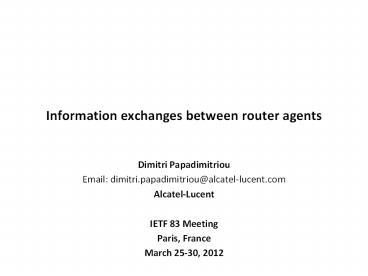Information exchanges between router agents - PowerPoint PPT Presentation
Title:
Information exchanges between router agents
Description:
Information exchanges between router agents Dimitri Papadimitriou Email: dimitri.papadimitriou_at_alcatel-lucent.com Alcatel-Lucent IETF 83 Meeting Paris, France – PowerPoint PPT presentation
Number of Views:49
Avg rating:3.0/5.0
Title: Information exchanges between router agents
1
Information exchanges between router agents
- Dimitri Papadimitriou
- Email dimitri.papadimitriou_at_alcatel-lucent.com
- Alcatel-Lucent
- IETF 83 Meeting
- Paris, France
- March 25-30, 2012
2
What's an agent ?
- What is an agent?
- Autonomous and adaptive decision-making discrete
entity with heterogeneous properties,
individual/shared goals and modifiable behaviors - Agents have internal states (attributes,
data,...) memory storing observations
(descriptions, representations of environment,
etc.) - Agents interact with their environments beyond
concurrent state-determined interaction - Adapt decision on future action to environment
changes using sequence of k observations of k
past system state (next action not solely
dependent on previous state but depends also on
some memory) - ... but also on using agents beliefs about
other agents or the utility of performing some
actions, etc.
Function
memory
Object
autonomy adaptivity
Agent
3
Router's Agent
- Agents running on routers (N1), 0 ? N lt ?
i
...
a
n
Routing Engine
Routing Engine
Fwd'ing Engine
Fwd'ing Engine
4
Multi-Agent System
- Non-uniformly distributed set of interacting
(software) agents - Each agent receives a separate partial
observation of the environment - No central control entity shared between agents
- When agent are running on routers
Task attack doesn't further propagate
ext
attack
ext
ext
5
Applications
- Two classes
- Networking layer-related
- Diagnostic, analysis
- Distributed intrusion detection, immunity
- Others
- Information routing related (caching/storage,
processing, etc.) - etc.
- In both cases, different objects / information
units than those associated to legacy network
layer routing (link states, vector, etc.) - Routers' components programmability is by
definition going to accelerate these trends
6
Communication between agentsCurrent situation
- Routing protocols (network layer information
exchange and processing) - vectors
- states
- The "multi-", "opaque-", "extended-" ... problems
(because of communication-memory-processing cost) - 1) PUSH mode inefficient when applications are
operate at different time and spatial-scale - 2) Overlaying is only one out of many means to
add functionality (--D.Wheeler quote) - 3) Determinism vs uncertainty (stochastic nature
of events, interactions, environment, etc.) - Corollary (out of 3) pushing the uncertainty out
of the routing system (ignore it) will in the
long term make the system itself under-performing
-gt compute routes
7
Communication between agentsWhat would we need ?
- 1) PUSH mode inefficient when applications are
operate at different time and spatial-scale - -gt Hybrid push-pull information communication
mode for router's agent to operate at multiple
time-scale and multiple space-scale - 2) Overlaying is only one out of many means to
add functionality - -gt Routers comprise multiple software agents
run-time behavior (instead of being structured
along a stack of functions with static and
invariant bindings) - 3) Determinism vs uncertainty
- -gt Impossible to ensure "perfect" placement of
agents (impossible to fully anticipate) gt
cooperation between agents from interaction
patterns
8
Summary
- Agent adaptive and autonomous statefull entity
(memory) implementing various functions - If agents run on "routers" (entity hosting
routing and forwarding function) then the routing
system becomes also a multi-agent environment - multi ? distributed
- actually routing and forwarding are also agents
but since these agents define the entities
themselves and are tightly intricate they are
hard to dissociate - Consequently
- We need to enable exchange of information between
agents to perform - Is the IETF the place to specify this protocol
... BoF in Vancouver































